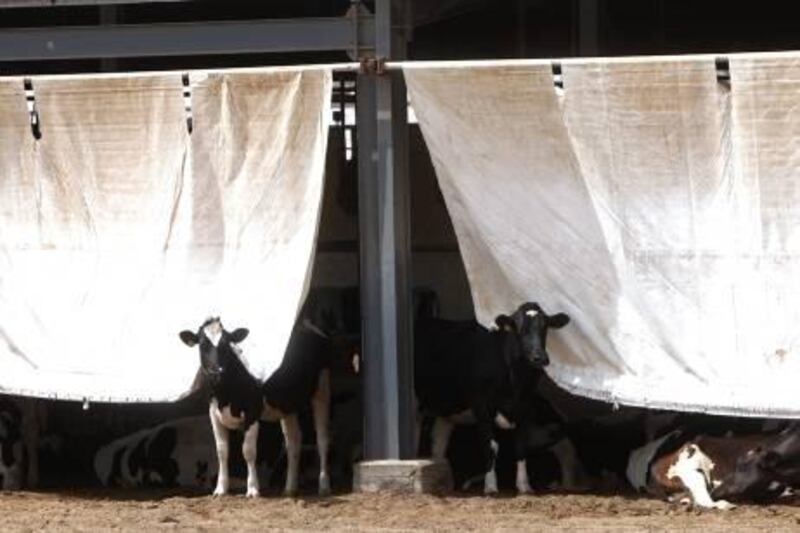DUBAI // The country's largest milk producer is holding its second annual farm festival this weekend, and expects to draw in about 50,000 people to tour the farm.
"It's a change for people in Dubai, who are used to malls and movies," says Ahmed Rahem al Mansouri, the general manager of Al Rawabi.
"Few people know there are any dairy farms out in the desert, so it's a good chance for them."
Last year, on the company's 20th anniversary, more than 60,000 people turned up at the festival.
Yesterday morning, more than 15,000 schoolchildren took tours of the farm. Al Rawabi expects thousands more as its doors open to the public today and tomorrow.
"When we tell them our milk is fresh, they doubt it," says Shivaji Gopala Pillai, the brand manager, adding that touring the farm will allow consumers to ask questions and understand the process. But visitors may be surprised to learn just how much technology is used to keep the farm churning out around 250,000 litres of milk a day.
With more than 10,000 Holstein and Friesian cattle spread across 300 acres of farmland, it follows a strict programme to ensure the health and safety of the cows, and the end products.
The cows are kept in paddocks and cooled by white sheets, water sprayers and fans. They are milked three times a day and, during each milking, the paddock is cleaned out and disinfected while the herd is checked by the staff.
If any animal looks unhealthy, it must then be checked by one of the company's three vets.
Operations run 24 hours a day, and at any given time around 180 cows are in the milking parlour. The operation is largely automated, from milking machines to automatic gates.
Milking machines with four teat cups, a long milk tube and a pulsator are used to harvest large quantities of the product. These machines work in a different way from hand-milking or suckling. The teat cups are held on by a continuous vacuum, which also massages the teat to release the milk.
The cups pulsate around once per second to relieve pressure on the teat. The milk is then delivered into a holding tank, which is collected several times a day and taken to the on-site pasteurisation plant.
Before being pumped into the silo, the milk's bacteria count is checked. It is then pasteurised at 75°C, to retain its proteins, calcium and other nutrients.
"Ours is the only company where the plant is adjacent to the parlour, around 500 metres away," says Dr al Mansouri, adding that other companies have separate facilities up to 200km away. "As the milk transports, it has the chance to grow a higher bacteria count."
The farm is designed around the milking parlour, with most paddocks, and even the calf holding pens nearby.
Al Rawabi's 4,000 calves are kept in separate, individual sheds, and bottle fed. Later, at around two years, they are old enough to be entered into the breeding programme.
All the animals undergo artificial insemination. Al Rawabi continuously culls low-producing or ill animals.
"We also do genetic culling, so if a mother exhibits an illness that is genetic, or a calf has a genetic malformation, we get rid of the mother and the calf," says Rami Hamad, the farm manager.
Good breeding remains a key part of the farm's success, says Dr Hamad. Pinned to the wall of his office is a list of the top 100 bulls in the world, updated every three months. "This way we know where to get our studs," he says. Dr Hamad insists that keeping track of every small detail, down to a whose who of sperm donors, is essential to running a successful farm.
Daily information on milk yields, bacteria counts, percentage of butter fat, udder infections and injuries are all recorded on the wall.
According to Dr Hamad, there is a record of each animal's production and health from the day it enters the farm. But, he adds, it is the breeds themselves that provide a superior texture to the milk.
Most large dairy producers in the region rely solely on Holstein, which produce a large quantities of thinner milk. By also milking Friesian breeds, Dr Hamad says they are able to provide whole milk with the highest fat content in the region - 3.6 per cent versus 3 per cent.
For Dr Hamad, the claim is easy to prove. "There's a simple test," he says. "Boil milk and leave it overnight. The next day, see who has the thicker layer of butter fat. It will always be ours."






